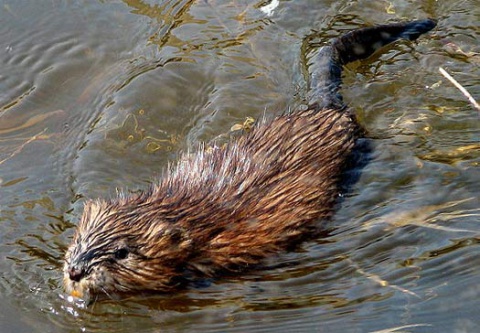
09 Aug 2020 SECOND UPDATE OF THE LIST OF INVASIVE ALIEN SPECIES OF UNION CONCERNS
On the 15th of August 2019, the second update of the invasive alien species of union concerns entered into force.
The additions consist of 5 animals and 13 plants. The list counts now 66 species (new species in bold):
PLANTS
| Scientific name | English name |
| Acacia saligna (Acacia cyanophylla) | Golden wreath wattle |
| Ailanthus altissima | Tree of heaven |
| Alternanthera philoxeroides | Alligator weed |
| Andropogon virginicus | Broomsedge bluestem |
| Asclepias syriaca | Common milkweed |
| Baccharis halimifolia | Eastern baccharis |
| Cabomba caroliniana | Fanwort |
| Cardiospermum grandiflorum | Balloon vine |
| Cortaderia jubata | Purple pampas grass |
| Eichhornia crassipes | Water hyacinth |
| Elodea nuttallii | Nuttall’s waterweed |
| Ehrharta calycina | Perrenial veldt grass |
| Gunnera tinctoria | Chilean rhubarb |
| Gymnocoronis spilanthoides | Senegal tea plant |
| Heracleum mantegazzianum | Giant hogweed |
| Heracleum persicum | Persian hogweed |
| Heracleum sosnowskyi | Sosnowsky’s hogweed |
| Humulus scandens | Japanese hop |
| Hydrocotyle ranunculoides | Floating pennywort |
| Impatiens glandulifera | Himalayan balsam |
| Lagarosiphon major | Curly waterweed |
| Lespedeza cuneata (Lespedeza juncea var. sericea) | Chinese bushclover |
| Ludwigia grandiflora | Water-primrose |
| Ludwigia peploides | Floating primrose-willow |
| Lygodium japonicum | Vine-like fern |
| Lysichiton americanus | American skunk cabbage |
| Microstegium vimineum | Japanese stiltgrass |
| Myriophyllum aquaticum | Parrot’s feather |
| Myriophyllum heterophyllum | Broadleaf watermilfoil |
| Parthenium hysterophorus | Whitetop weed |
| Pennisetum setaceum | Crimson fountaingrass |
| Persicaria perfoliata | Asiatic tearthumb |
| Prosopis juliflora | Mesquite |
| Pueraria lobata | Kudzu vine |
| Salvinia molesta (Salvinia adnata) | Salvinia moss |
| Triadica sebifera (Sapium sebiferum) | Chinese tallow |
ANIMALS
| Scientific name | English name |
| Acridotheres tristis | Common myna |
| Alopochen aegyptiacus | Egyptian goose |
| Arthurdendyus triangulates | New Zealand flatworm |
| Callosciurus erythraeus | Pallas’ squirrel |
| Corvus splendens | Indian house crow |
| Eriocheir sinensis | Chinese mittencrab |
| Herpestes javanicus | Small Asian mongoose |
| Lepomis gibbosus | Pumpkinseed |
| Lithobates catesbeianus | American bullfrog |
| Muntiacus reevesi | Muntjac deer |
| Myocastor coypus | Coypu |
| Nasua nasua | Coati |
| Nyctereutes procyonoides | Raccoon dog |
| Ondatra zibethicus | Muskrat |
| Orconectes limosus | Spiny-cheek crayfish |
| Orconectes virilis | Virile crayfish |
| Oxyura jamaicensis | Ruddy duck |
| Pacifastacus leniusculus | Signal crayfish |
| Percottus glenii | Amur sleeper |
| Plotosus lineatus | Striped eel catfish |
| Procambarus clarkii | Red swamp crayfish |
| Procambarus fallax f. virginalis | Marbled crayfish |
| Procyon lotor | Raccoon |
| Pseudorasbora parva | Stone moroko |
| Sciurus carolinensis | Grey squirrel |
| Sciurus niger | Fox squirrel |
| Tamias sibiricus | Siberian chipmunk |
| Threskiornis aethiopicus | Sacred ibis |
| Trachemys scripta | Red-eared, yellow-bellied and Cumberland sliders |
| Vespa velutina nigrithorax | Asian hornet |
Hunters play a significant role in the surveillance, management and eradication of IAS in Europe and, in most cases, this work is undertaken voluntarily (see the FACE Biodiversity Manifesto).
European hunters should note that all Member States are obliged to establish management measures for invasive alien species of Union concern in their territory. Those measures shall aim at eradication, population control or containment. For widespread IAS, there is no eradication obligation, but it is the prerogative of the Member State to select measures appropriate to its specific circumstances and based on an analysis of costs and benefits. FACE encourages its Members to work with relevant Ministries to ensure that hunters are part of the management of IAS.

